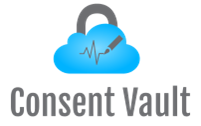Ethically Unlock Your Patients Data

Cloud Based Software As Service
Software As a Service
Patient Focused
Patient Focused
Improved Compliance And Reduced Liability
Improved Compliance And Reduced Liability
Consented Data Analysis
Consented Data Analysis
Consent Vault Mission and Vision
Revolutionizing Health Data Management Beyond Consent
At Consent Vault, our mission is to empower oncology practices and patients by providing essential tools for ethically and transparently connecting personal health data. Through robust consent mechanisms, patient control features, and streamlined approval processes, we ensure the secure and compliant use of health data. Join us in revolutionizing healthcare data management for better patient outcomes and enhanced research insights.
Our vision is to create a future where health data assets drive ethical pioneering research and innovation
in preventive and personalized medicine, propelling drug discovery and development advancements.
Powered by AI and Machine Learning
Comprehensive Patient Data Analysis
Our patented AI and machine learning software couples comprehensive data analysis with clinical progress information, enabling the profiling of patient biology and response for optimized clinical approaches. This user friendly dashboard facilitates the monitoring of therapeutic progress enhancing healthcare management decisions.
Furthermore, molecular features, tumor, and liquid biopsy genomic profiling are now leveraged to optimize therapy through precision medicine and patient-centered clinical trials by matching therapeutic agents to patients based on their tumor biomarkers.
Learn how you can leverage our patented data analytics tools and workflows to improve your patients outcomes.
A Modern Approach to Informed Consent and Biomedical Data Analytics
Consent Vault Features
Advancing Precision Medicine
Why Chose Consent Vault
Consent Vault’s biomedical data analytics expertise enables the alignment of responsible data practices with ethical considerations, prioritizing patient welfare. Their capabilities can enhance therapeutic advancements and streamline clinical trial enrollment and management, potentially mitigating the $50-60 billion annual loss attributed to failed oncology trials. Furthermore, through the capture of real-world, real-time data and the utilization of digital applications, machine learning, artificial intelligence, and large language modeling, drug discovery and development can be accelerated, leading to the tailored matching of therapeutic agents to patients’ tumor biomarkers and diagnostic profiles.
Facilitated by our Patented Consent Workflows
Get Informed Consent Right
By revolutionizing informed consent and data sharing through our patented electronic and clinical workflow, we empower clinics with informative outreach and consent processes. Our patient-centered approach connects clinical and diagnostic data assets throughout the patient’s diagnostic and treatment journey. With our simplified workflows, our software reduces administrative burdens and paperwork within your practice. Our software emphasizes patient data control, enabling specific permissions regarding data access, types, and purposes.
Transitioning seamlessly from facilitating informed consent and data sharing to enhancing patient communication and awareness, our educational outreach tools, facilitated by our clinical workflows, ensure streamlined communication and awareness regarding clinical and therapeutic plans for your patients.
Built by Industry Experts
Meet the Consent Vault Team
Frequently Asked Questions
“Our purpose, partnering with healthcare providers, is to assure ethical and transparent management of patient healthcare data, properly and legally consented, for use in tracking clinical and therapeutic progress, connecting genomic and diagnostic data for a precision medicine approach, advancing research and development, and profiling for optimal fit for clinical trials … all as a trusted partner with patients and providers.” Tim Miller, CEO

The velocity of data generation is enormous and those who harness the power of data to enable innovation are the future winners but that data must be legally and transparently permissioned and consented. Even after the data is properly consented identifying and analyzing this data can be overwhelming and that’s where Consent Vault makes the entire process seamless. Our Patented workflow software and AI powered tools can help your clinic consent and understand the data you have available to improve precision medicine, clinical trial enrollment and data sharing initiatives.
Healthcare data assets are key inputs to drive future innovation in precision medicine but those data assets must be voluntarily consented which is the first step of the Consent Vault workflow process. Properly consenting patient data can unlock new insights through our biomedical data analytics tools.
Healthcare data enables exciting and innovating medicine of the future and ESG is mission critical to ensure that data is obtained and governed in an ethical and transparent way. Consent Vault is at the center of enabling this and providing you with the technology your clinic needs to receive consent and understand your patients medical data. Our software advances your precision medicine in community oncology clinics.
A key step in providing care to a patient is providing them with education materials about their visit, clinical trial, procedures and therapeutic plan. Our workflow software allows a clinic to integrate education materials that can be sent to a patient, as needed.
